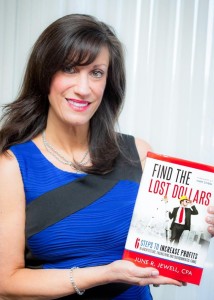This post is part of Demystifying AEC Tech: A Series Profiling AEC Next Expo Presenters. For more on the cutting edge of AEC tech, see the other parts here.
June Jewell spent 25 years selling the Deltek enterprise resource planning (ERP) solution to engineering and architecture firms. One her pet peeves is that many of these firms weren’t very businesslike in their practices. It’s as if they all missed Business 101, and because of that, they are hurting themselves and their employees, wasting time and losing money.
 For every problem in the business world, though, there often is at least one viable solution. When Jewell saw an opportunity to help lots of AEC companies do better, she launched Acuity Business Solutions. The idea is to educate firms in how they are wasting money through inefficient processes, to change the company’s behavior and save money.
For every problem in the business world, though, there often is at least one viable solution. When Jewell saw an opportunity to help lots of AEC companies do better, she launched Acuity Business Solutions. The idea is to educate firms in how they are wasting money through inefficient processes, to change the company’s behavior and save money.
She will speak at the conference about Best Practices for Architecture and Engineering Firms.
Just as accountants representing law firms scrutinize where money is being spent, she said, any professional services firm must also have a bean-counter mentality in order to make the firm as profitable as possible.
“Professional services firms sell time for a living, and if they lose time because of inefficiencies, they can never get that time back,” Jewell said.
Her company’s consulting process begins with a business management assessment of the client firm’s people, processes and systems—a 160-question survey that covers 27 dynamics. It’s filled out by employees anonymously. Its results help to show where the firm can work to improve productivity, where money might be being wasted, how well systems are performing and more.
Next, her company conducts some in-depth conversations with the client firm.
“First, I want to talk to their leadership, and understand their goals. Do they have big projects, or other challenges they are facing?” Jewell said. “I am a CPA, and so I focus on the numbers. When you are trying to motivate a company’s leadership, showing them the numbers is very helpful.”
Saying it is helpful is one thing, but just as it is with many companies’ leadership, the proof is in the numerical pudding, so to speak. Jewell’s proof is substantial, and can’t be argued with: With just a 1 percent increase in utilization, at a firm comprised of 100 people, the company gains an extra $500,000 in savings per year, she said.
Honesty is key. Being clear about goals, and the reality of a businesses’ numbers, is paramount. “We encourage our clients to be transparent with their employees, and to show the numbers,” she said. “Processes need to support the employees.”
Some might question how Jewell’s approach would make a difference and help a much smaller firm. They all need help, she said.
“We worked with a 40-person firm and they put half of the employees through our training. In less than a year, they increased their profits by $475,000, in part through better utilization” of the company’s resources, Jewell said. “Their profits had been terrible for years and they are now having the other 20 employees take the training… Every employee is either contributing to the bottom line or subtracting from it.”
Another firm Jewell served put their tech people and administrative staff through her program (87 employees in total). The company’s profits increased by 5% in one year. One of the company’s divisions increased its profitability from 3% to 22% per year.
Sometimes Jewell and her team find commonalities between architecture and engineering companies. A full 90% of such firms lose money through scope creep, or uncontrolled changes and continual growth in a project’s scope. 2-4% percent of such companies’ revenues are lost this way.
Their systems are out of whack.
“If you have crappy systems, then you will lose money,” she said. “I recommend that a company really understand their system and tools. I have found that if they are not using the system, it often has to do with the people and processes, not the system… You really have to go through that analysis to understand why you’re not utilizing your current system before you get another, because if you don’t you’re probably going to end up with the same issues.”
The topic is rather obvious to Jewell, who considers herself fortunate to be helping firms streamline their operations and become more profitable. Perhaps the icing on the cake for her professionally is that she truly likes to help—even more than she enjoys having her own successful firm. She believes in results, and in spreading the joy that such savings and efficiencies bring to businesspeople and the firms for which they work.
“Who wants to do something they don’t feel is adding value? I had a successful business for 25 years, but I wasn’t happy, because I didn’t have control… My goal here is to do something to make a large difference. I love the work because I can make a difference,” she said.
In closing, she notes that she wants companies that are interested in improving their systems to focus on how the tech tools they use are a strategic investment. “The technology has to give a return on investment and if it’s not doing so, that tool is not working… But a lot of companies don’t even know what that ROI should be. Everything has to be measured, to determine if it’s working or not.”
To meet Jewell and see her presentation, come to AEC Next on June 5-7 in Anaheim. The conference and expo will feature a wide range of presentations and vendors of the latest AEC technologies. Register now.






